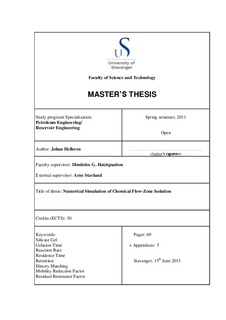| dc.description.abstract | Silicate gel has been mostly used for near well treatment. A field test in the Snorre reservoir on the Norwegian Continental Shelf (NCS) has been planned, where the object of the test is to technically qualify silicate gel for deep placement. Compared with other types of gel, silicate gel is relative inexpensive, environmentally friendly and flexible.
The chemistry and polymerization process of silicate gels is complex. The silicate gel gelation time is affected by several parameters such as pH, temperature and concentration of the components. In order to optimize the silicate injection test planned in the Snorre reservoir, several experiments on silicate gel were conducted at the International Research Institute of Stavanger (IRIS). Bulk gelation, static and dynamic coreflood experiments were performed, with the aim of studying the kinetics and strength of the silicate gel. The experimental data obtained from the experiments were used to model the coreflood experiments to get a better understanding of the gel behaviour. The commercial numerical simulator, STARS was used for this purpose. Gel modelling capabilities in STARS is primarily based on a defined chemical reaction, and the adsorption/retention of a defined pure blocking gel.
The formation of gel in STARS is dictated by the chemical reaction implemented into the simulator and the reaction rate of the reactants. Gel modelling in STARS was not fully understood, since large amount of gel was created in the start of the run. To solve this issue, a critical gelation time and critical gel concentration terms were introduced, in order to reach the maximum gel adsorption level at the predetermined gelation time. The blocking effect in STARS is mainly controlled by the reduced water permeability factor RKW, which is primarily affected by the residual resistance factor RRF.
Dynamic coreflood and static coreflood were modelled to study the gelation time and the gel strength. In the dynamic coreflood, the relative effluent concentration and differential pressure were sampled during the experimental work. To be able to match the differential pressure, the RRF had to be adjusted at the plugging time of the core. The relative effluent concentration matched well with the data obtained from the simulation results at high injection rates. By changing the order of reaction of the reacting components, a better match can be obtained for the lower injection rates.
For the static coreflood the mobility reduction RF, and the residual resistance factor, RRF were sampled during the experimental work. A good match was obtained for the RF. To be able to match the RRF, connected with the differential pressure during the experiment, the adsorption had to be set as irreversible at 5000 < RRF < 20, and reversible outside this range.
Utilising the STARS simulator gel creation and behaviour modelling capabilities it is possible to simulate and match silicate gel treatment results observed from various experimental coreflood runs. | no_NO |
